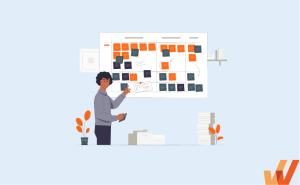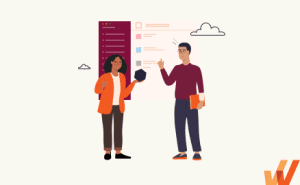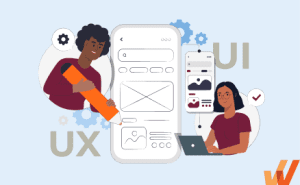When it comes to workplace learning and development, engagement is vital. L&D teams can provide employees with a wealth of information, but unless it is delivered in a way that learners can digest and interact with, training programs can fall flat.
For learners to truly understand the information provided in training and be able to incorporate what they’ve learned into their work, an added level of humanity is necessary.
What Is Learning Experience Design?
Learning experience design, or LxD, is a human, experience-oriented approach to designing educational content. According to its creator, Niels Floor, LxD pulls together principles of user experience and user interface design to “enable the learner to achieve the desired learning outcome in a human-centered and goal-oriented way.”
Learning experience design focuses on empathy and authentic connection with the learner. With LxD, learning is meant to be comfortable and enjoyable. Through experiential learning methods such as active participation, reflection, and success, LxD keeps learners engaged by drawing on their own experiences and helps improve learning outcomes.
Learning Experience Design (LxD) vs. Instructional Design?
Learning experience design and instructional design can be challenging to tell apart as they have similar aims but differ in terms of origin, perspective, methods, and tools. Instructional design employs a more scientific perspective, focusing on developing content to fit parameters set by the larger institution. It takes a more methodical approach, intending to provide clear, structured information.
Learning experience design, on the other hand, tends to be more creative, focusing on meeting the needs of learners, allowing them to take unique, sometimes less linear paths toward understanding.
4 Components of Experiential Learning
Building training programs based on the following components ensure more efficient and effective paths to learning.
1. Real-life experience
In the initial stage of training, learners will perform an activity related to the skillset they seek to build. These activities are everyday experiences that employees encounter on the job.
This is an important component of experiential learning, as the 70-20-10 model suggests that 70% of employee learning should come from experiences.
2. Reflective observation
Next, learners pause to contemplate the experience they just had. They should ask themselves several questions at this point: What did they learn throughout the process? What might they still need to improve upon? What are they still unsure about?
3. Abstract conceptualization
Now things get more exciting. From here, learners make mental connections based on their experiences and reflections. These connections help them understand the big ideas behind their learning and connect them to what they already know. This information can then be used to formulate a plan moving forward.
4. Active and continuous experimentation
Experiential learning is an iterative process. Now employees can return to the activity or task, using different techniques to determine the approach that works best for them. This element of experimentation allows learners to create new experiences, develop new theories, and hone their problem-solving skills as they seek the best approach for them.
Elements of Learning Experience Design
Here are some of the most important elements of learning experience design.
1. Design
Learning experience design as a process is similar to many other forms of design. Learning experience designers conduct research, experiment with different approaches, and eventually develop and test their concepts through an iterative process. This process is creative and variable, like other design disciplines. What makes it unique is its purpose of building educational experiences that optimize learning.
2. Learning
LxD focuses on the learner and their experience rather than the instruction or the information being taught. Through this lens, the learning process matters and poses as many benefits as the intended learning outcomes. Taking this approach to digital course design requires empathy and an understanding of how experiential learning works.
3. Human-centric
LxD focuses on the learner at every point in the design process. This element is what makes LxD so unique among all educational design approaches. To shift the focus of L&D programs to learner experience, course designers and L&D teams must communicate with their learning base to understand what they need in a learning environment. This can be done by conducting surveys before and after the training session.
4. Goal-oriented
Learning experience design also centers on goals in the learning process. Each lesson or training program must have clear goals that learners aim to reach as they progress through their learning journey. Learning experience designers must incorporate specific, attainable goals into the experience to guide learners along their paths.
How to Apply Learning Experience to Your L&D Programs
Shifting to learner-centered training shouldn’t require a full reworking of workplace training initiatives. The principles of LxD can be incorporated directly into existing learning and development programming in several ways.
1. Create an inclusive learning experience
One of the most important ways to apply LxD to employee training efforts is to consider programs, from start to finish, through the lens of employee learners. Doing this will illuminate opportunities to make lessons and delivery methods more accessible and enjoyable for trainees.
This might mean making lessons shorter, adding opportunities for collaborative learning, or adjusting language to be more inclusive. In the end, learning content must be delivered in a way that’s appropriate for learners, and it should cater directly to the needs of employees.
2. Encourage social engagement
Based on learning experience design principles, L&D programming should reflect real-life experience to maximize learning. Few roles are entirely solitary in nature, so employee training must be built to integrate social aspects of tasks as well as purely instructional information.
3. Create a media-rich learning experience
L&D teams understand the importance of engagement in creating effective training programs for their organization’s employees. Through LxD, course designers can boost engagement by incorporating a variety of media into the employee experience design. Just like in-person learning benefits from incorporating different activities such as quizzes, games, and discussions, digital learning content can utilize similar tools to keep learners energized.
4. Use a blended learning approach
Over the past several years, eLearning has become more commonplace as employees have shifted to working from home. There are a variety of different approaches to designing learning experiences in a digital space, but through an LxD lens, these experiences must use a blend of real-time and asynchronous methods.
This means some parts of the lessons incorporate natural, in-the-moment collaboration or instruction, while other components are completed at the learner’s discretion. This combination keeps the learner at the center, giving them more flexibility and agency in their learning process.
5. Split a huge text into smaller chunks
One of the fastest ways to lose learners’ attention is to provide them with dry, dense training material. Of course, the topics might be dense, but LxD approaches show us that breaking up that information and making it interactive can improve employee experience and help process the information easily.
Upskilling Better Clicks With Whatfix
Investing in the right tool for your learning and development can make all the difference. When employees are equipped with the right resources, materials, and platforms to learn — and retain — a new skill or process, you can see positive returns on learning investments. Not only will your employees feel more fulfilled with their jobs, but they’ll be more productive and engaged with their work.
Whatfix is a digital adoption platform (DAP) that provides powerful content creation tools for organizations to create in-app learning experiences such as guided walkthroughs, task lists, smart tips, and more – allowing employees to learn in the flow of work.
To know more about Whatfix learning, schedule a free demo with us today!













